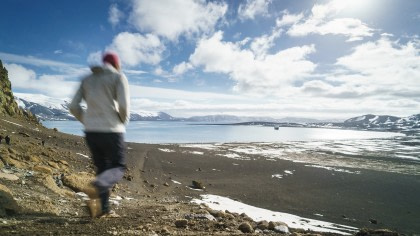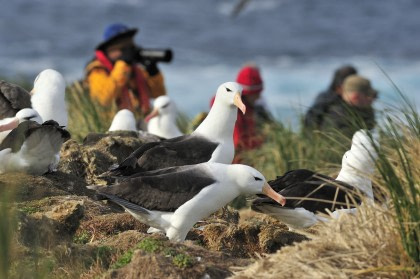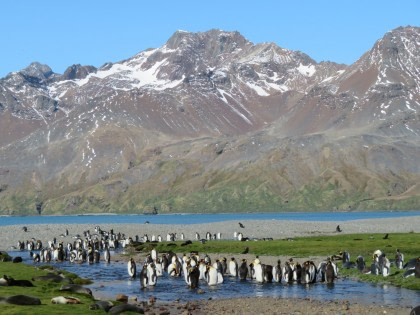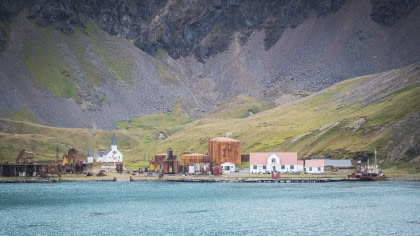In April 1916, aided by south-westerly winds, a small, 22.5-foot wooden boat, the James Caird, set out from the desolate shores of Elephant Island manned by six men. They took with them the desperate hopes of 22 others left behind at the mercy of the Antarctic.
The journey that followed, the dramatic climax to a tale of Antarctic endurance that began in February of the previous year, would be written into legend as one of the most remarkable maritime feats in history and an embodiment of the human spirit that defined the period of history known as the Heroic Age of Antarctic Exploration. Discover this epic tale in full, and learn how you can follow in its wake on one of our Antarctica expedition cruises.
Trapped in the ice - the perils of Antarctica
The Imperial Trans-Antarctic Expedition, led by the renowned polar explorer Ernest Shackleton, set out aboard the ship Endurance, aiming to complete the first land crossing of the continent via the fabled South Pole. Between 7 December 1914 and early January 1915, the ship's crew struggled to navigate a way through the ice. By February 1915, Endurance was stuck in the pack, drifting deeper into the Weddell Sea.

Endurance was lost after a long winter in freezing darkness, and Shackleton's crew was stranded on the ice. Over the following four months, the party headed north, dragging sleds laden with salvaged supplies and three lifeboats. Shackelton planned to make for one of several destinations, including Deception Island, Clarence Island, and Elephant Island. He knew that Deception Island held emergency stores and that whalers infrequently visited it, making it a good option for rescue.
The ice drift was unpredictable, however, and took them further east. By April 1916, the floe beneath their camp began to break up, forcing the men to take to the boats on 9 April. Initially aiming for Deception Island, difficult conditions, including temperatures as low as -20 °C and failing morale, forced Shackelton to instead make for Elephant Island, landing on 15 April 1916.
Ashore on Elephant Island
Now back on land but no closer to rescue, the 27 men made camp. If they were to survive, they had to summon help. This lay 1,300km away, across the treacherous Southern Ocean, at the whaling station on the island of South Georgia. While a camp was established, Shackleton made plans for an audacious voyage, working with the ship's carpenter, Henry 'Chippy' McNish, to reinforce one of the Endurance's lifeboats, the James Caird, with a deck and raised sides and supports to help the small boat brave the waves and swells ahead.
Shackleton, along with five expedition members, Henry McNish, John Vincent, Timothy McCarthy, Frank Worsley, and Tom Crean, stocked the small boat with provisions for one month, two small Primus stoves, sleeping bags, and as much clothing as could be spared by the men left behind. By mid-April, the camp on Elephant Island was being battered by gale-force winds and flattened by blizzards. The time to go was now.

On 24 April 1916, the James Caird pushed out from the shores of Elephant Island, waved off by the party of 22 men who consigned themselves to further waiting, huddled around a stove burning penguin and seal fat, their faces and clothing stained black by the soot and grease that was keeping them alive.
Braving the open southern seas
The small boat battled force nine winds and immense swells as the navigator, Worsley, charted a course to avoid the growing ice fields further east. Time aboard consisted of rotating watches, handling the sails and the helm, and taking observations to determine their position and heading. As they entered the notorious Drake Passage, the boat was rocked by heavy seas and giant waves. Life aboard the James Caird was wet and miserable, with the limited cover in the bow acting as cramped crew quarters.
By 29 June, the boat had traveled 441km and soon encountered the worst weather. There was a constant risk of capsizing, and continual bailing out of water was required to keep the James Caird afloat. As temperatures fell, spray began to freeze on the deck, with accumulations on the mast and rigging threatening to capsize or sink the boat. The men took it in turns to chip away desperately in the darkness.
By 6 May, Worsley calculated their position to be 213km from the western point of South Georgia, albeit still being tossed like a cork amidst breaking waves and fierce winds. After two weeks at sea in appalling conditions, John Vincent collapsed under the strain, and Timothy McCarthy and Henry McNish were severely weakened. On 8 May 1916, they sighted South Georgia. Hurricane-force winds prevented their approach for two more days. Finally, on 10 May, the James Caird made landfall in King Haakon Bay on the northeast coast. One of the greatest voyages by boat, lasting 17 days and covering some 1,300 km, had been completed. Yet, their journey and their suffering weren't yet over.
The final push: crossing south Georgia on foot
As Shackleton and his party recuperated in King Haakon Bay, it became clear that his initial plan to hug the coastline to reach the whaling station on the island's far side at Grytviken would be impossible. His men were also severely weakened, and Vincent and McNish could not continue.
On 18 May, Shackleton, Worsley, and Crean left Vincent and McNish in McCarthy's care at a location christened 'Peggotty Camp'' and set out, map-less, to traverse the wild interior of South Georgia by foot. They aimed towards the station at Stromness and headed into a landscape of glaciers and mountain ranges. They lacked any equipment and wore only the blubber-stained clothes that had served them since the loss of the Endurance over a year and a half earlier.
The trio traveled continuously for 36 hours before stumbling, exhausted and weakened into the small Norwegian whaling station at Stromness. They had made the first known crossing of South Georgia by foot. By 21 May, a Norwegian whaler had picked up the three men left behind in King Haakon Bay, and almost immediately, Shackleton began to organize the rescue of the 22 men left behind on Elephant Island.
It took Shackleton four attempts to return to his men. It would not be until 30 August 1916 that those on Elephant Island were rescued by the steam tug Yelcho, bringing to an end one of the most dramatic tales of Antarctic endurance and over 24 months of isolation and suffering in the wild, unforgiving, and frozen south.

Begin your own Antarctica cruise adventure
Several of our trip itineraries to Antarctica include visits to some of the locations from Shackleton's epic voyage. We visit South Georgia, Elephant Island, and Deception Island and venture deep into the Weddell Sea, where the wreck of the Endurance lies. You'll also cross the Drake Passage and cruise through the Southern Ocean, giving a glimpse of what life was like aboard the far smaller and far less comfortable James Caird.
Check out our full Antarctica program to start your very own polar adventure. Will you join us on a voyage across the sub-Antarctic or one of our excitement-filled Basecamp expeditions? You can also find answers to some of the most common questions, such as: ''How much is a cruise to Antarctica?'' ''What to pack for a cruise to Antarctica", and "What will I see on a cruise to Antarctica?" You can even visit Shackleton's grave in South Georgia and walk sections of the same route he took on foot.
Prepare to follow in the footsteps of Shackleton and his men!






